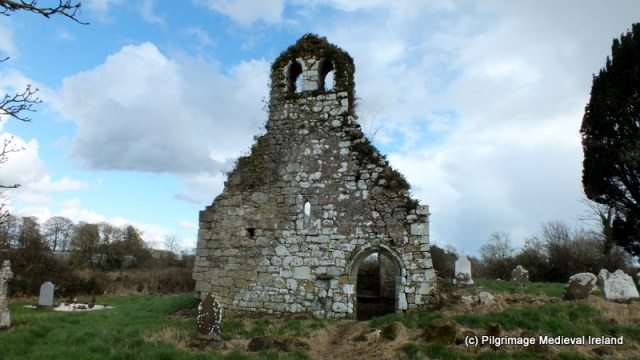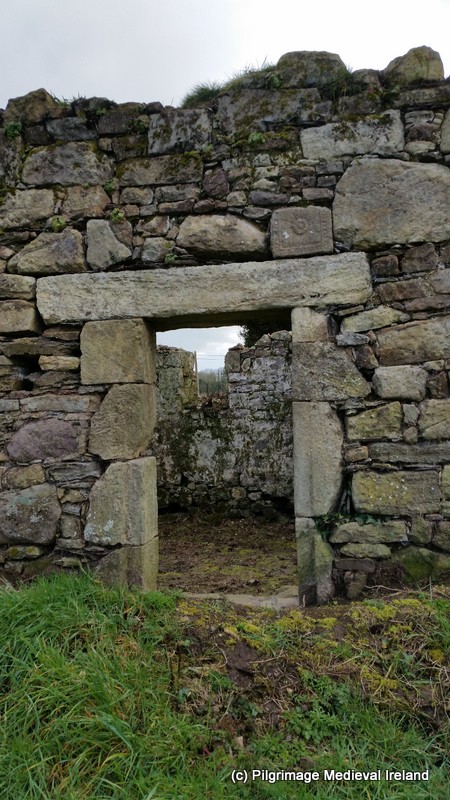Kilmolash church is one of my favourite places to visit. It is located close to the Cásan na Naomh (path of the saints) an off-shoot of the ancient road from Lismore to Ardmore called St Declan’s Road. Its roughly about 5 or 6 miles from the historic town of Lismore, the site of the great monastery of St Cathage/Mochuada . Kilmolash started out its life as an early ecclesiastical site dedicated to St Molaise who was venerated locally on the 17th of January. There is no evidence written or physical to suggest that the site was at any time a place of pilgrimage, although this can not be ruled out completely. The annals record that the site was plundered by Norsemen in AD 833. In AD 912 Cormac Mac Cuileannan, bishop and vice abbot of Lismore, King of Déisi is also recorded as the abbot of Cell-Mo-Laise (Kilmolash). Suggesting Kilmolash was in the sphere of influence of Lismore. By the later medieval period the church had become the parish church for the parish of Kilmolash.
Today the site consists of the ruins of a multi-period church surrounded by a D-shaped graveyard. The graveyard is defined by a wooden fence and an earth and stone bank. The modern by-road follows the curve of the graveyard.

Kilmolash church Co Waterford
The church is rectangular in shape and consists of a nave and chancel divided by a rounded chancel arch. The nave and east wall are largely late medieval in date while the chancel walls appear to be much earlier, possibly even 12th century in date (O’Keeffe 2003, 171).
This little church has many interesting architectural features and the west wall is particularly striking with its finely carved doorway with hooded moulding and holy water stoup.

West gable of Kilmolash church
The fabric of the building is constructed from sandstone and is in a poor state of repair and in need of some form of conservation especially the north and south walls.
A double belfry survives in the west gable positioned over an ogee-headed gallery window.

The nave and chancel are divided by a chancel arch. The arch is made of dressed stones, one of which bears the inscription Feare God, Honer the Kinge, Anno Dom 1635. Beneath the chancel arch is a large ogham stone. The inscription is worn but only the letters ‘NN’ can be identified (MacAlister 1945, vol. 1, 285-6). The stone also has two inscribed crosses located close to the ogham text. For more information on ogham stones visit Ogham in 3D project website.
The most unusual feature at the church is rare piece of Romanesque sculpture positioned over a flat linteled door in the west end of the north wall. The carving in question is a finely carved rosette stone (Power 1898, 91; O’Keeffe 1994, 129-32). A similar type rosette stone is found at Coole Abbey.

A flat lintel door in the north wall of the church. Note rosette stone over the lintel

Rosette stone at Kilmolash church
The graveyard surrounding the church contains many fine examples of eighteenth and nineteenth century gravestones and one late medieval gravestone with a figure carved on it found on the north side of the church. Today only the head can be discerned with some difficulty. The ITA files state that the head was believed to be the head of St Molaise (ITA files).
A fragment of a font is also found in the graveyard and likely the same as the one identified by Buckley in 1898 and found in the graveyard wall and kept in the church (Power 1898, 92). In 1894 Redmond recorded that ‘… a holy well exists in a field adjoining the church, but that it was covered in many years ago, and now no trace of it can be found’ (Redmond 1894-95, 155).

Fragment of medieval font in the graveyard at Kilmolash
Given its roadside location Kilmolash is easy to get too and a wonderful place to pass a some time and I highly recommend a visit.
References
Buckley, M. J. C. (1896) Notes on Kilmolash Church, Near Cappoquin, Co. Waterford, WAJ vol. 2, 212-20.
Buckley, M. J. C. (1896) Notes on Kilmolash Church, Near Cappoquin, Co. Waterford, WAJ vol. 2, 212-20.
Buckley, M. J. C. (1899) Ecclesiological gleanings and jottings in Waterford and elsewhere. (continued) WAJ vol. 5, 44-8.
Macalister, R. A. S. (1945) Corpus inscriptionum insularum Celticarum, 2 vols. Stationery Office, Dublin.
O’Keeffe, T. (1994) Lismore and Cashel: reflections on the beginnings of Romanesque architecture in Munster. JRSAI vol. 124, 118-52.
O’Keeffe, T. 2003. Architecture and Ideology In the Twelfth Century. Dublin: Four Courts Press.
Power, Rev. P. (1898) Ancient ruined churches of Co. Waterford, WAJ vol. 4, 83-95, 195-219.
ITA Files
http://www.crsbi.ac.uk/site/2317/
http://www.libraryireland.com/topog/K/Kilmolash-Decies-Without-Drum-Waterford.php








What an interesting site, full of unusual details
Is this the same Molaise as on Inishmurray?
Think its a different one but will check that out for you Finola
Not to worry…just curious.
[…] https://pilgrimagemedievalireland.com/2016/07/23/kilmolash-church-co-waterford/ [July 2020] […]